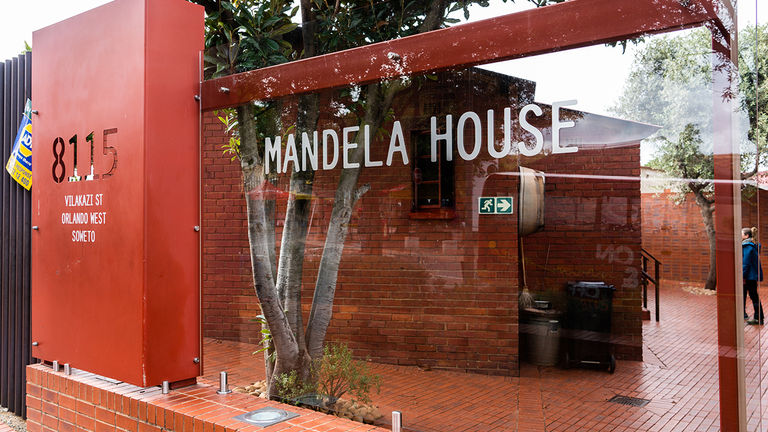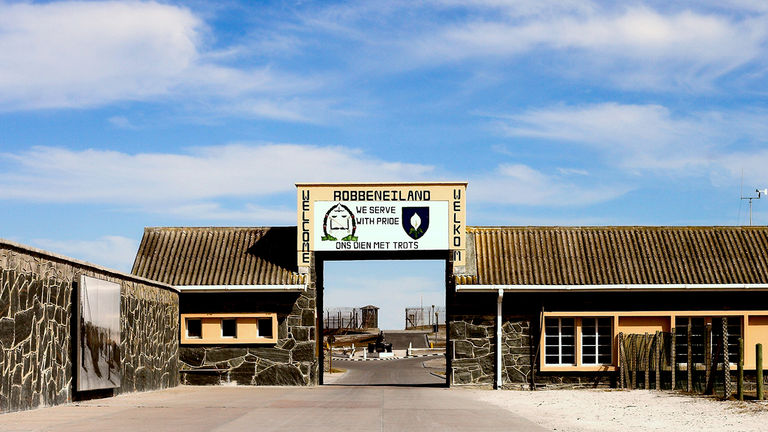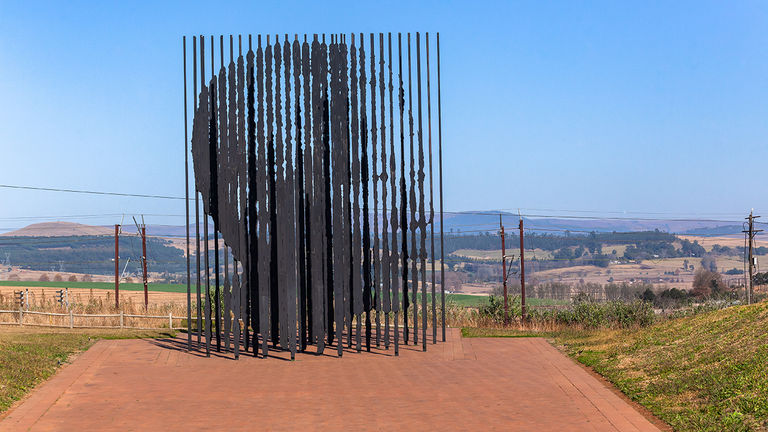He stands there like a man ready to rumble, eager to take on heavy challenges—or a championship sparring partner. His feet are firmly planted in high, lace-up boots, and his arms are raised and slightly coiled, at the ready for a fight. His young face is focused and serious, but still emotive, full of life.
“Nelson Mandela’s favorite sport was boxing, but unfortunately, he never had a chance to fight professionally,” my guide said as we walked through the late president’s former home, where I was staying for the night.
The photo I stared at, taken in 1953, shows a young Mandela, who had boxed as a student and used his physical training regimen as stress relief — being a leader for revolutionary change surely came with stress. This iconic black-and-white image presides over the upper hallways of Sanctuary Mandela, a new boutique hotel in the leafy, upscale Johannesburg neighborhood of Houghton.
Mandela lived here after his implausible 27-year imprisonment. Meticulously renovated, everything at the Sanctuary reflects the spirit of Madiba, as he was lovingly known. Paintings by photo-realist painter John Meyer trace Mandela’s life. There are nine guestrooms, each one bearing a different nickname and focusing on different phases of Mandela’s journey: activist and prisoner, statesman and president, for example. A menu in the restaurant was curated by a former personal chef, and includes Mandela’s favorite foods. I was only on the property for one night, but it was the perfect place to start a South African sojourn, allowing me to walk in the footsteps of a national hero.
When travelers stay at Sanctuary Mandela, they should ask for a tour. Enthusiastic staff members will take guests around the hotel, pointing out a number of fascinating details. Rooms are large and comfortable, many with deep tubs and all painted green, Madiba’s favorite color. There’s also a pool and gardens, ideal for lounging after a long flight or reflecting on the area’s meaningful surroundings.
When you travel to South Africa, Nelson Mandela is everywhere. Given that the man liberated and integrated the country, through quiet strength and the power of his spirit, Madiba’s image and name remains almost ubiquitous even 10 years after his death, on statues and murals, in place names. His placid, smiling visage even gazes back at you from banknotes. And every glimpse of him feels encouraging.
Nelson Mandela’s Former Home
On several visits to the country, I’ve had the pleasure of visiting key sites in the life of this extraordinary man. I spent an afternoon on Vilakazi Street in the township of Soweto, probably the only road in the world once home to two Nobel Peace Prize winners: Mandela, and the Archbishop Desmond Tutu, who lived just around the corner. In a small, humble house on this road, Mandela moved in with his first wife, Evelyn, in 1946.
 The Mandela House on Vilakazi Street in Soweto, South Africa
The Mandela House on Vilakazi Street in Soweto, South Africa
Credit: 2023 Mario Hagen/stock.adobe.comIt would remain a place of powerful action for decades, as he and second wife Winnie struggled against the racist, repressive apartheid regime. She would face police harassment there long after he was imprisoned, and eventually Winnie herself was banished to a remote part of the country, leaving her daughters to live here. Despite its diminutive size, you can feel its power. There are posted inspirational quotes and black-and-white photos documenting the pace of day-to-day life inside these walls. There are also scars on the red-brick exterior from bullets fired and Molotov cocktails, hurled.
Robben Island
Farther south, where the Atlantic Ocean meets the Indian, Mandela served 18 years of his prison sentence on Robben Island. On a helicopter tour of Cape Town, the island looks almost idyllic, set in a shimmering sea, the monumental rise of Table Mountain just across the way. But arriving by ferry, I learned about the hardships endured here. Even today, its stone walls and iron spaces remain grim.
A former prisoner led my tour, describing the hard labor they performed in a quarry, crouched on the ground and hammering away. The isolation was significant — Madiba could only see one visitor per year, for just 30 minutes. Adding to the discomfort was rain and hail and wind, coming straight through the bars. Mandela’s cell is preserved, a rough blanket on a concrete floor for his bed, a bucket for his ablutions. But it was here, the guide shared, that Madiba gained the endurance, patience and leadership abilities that would help so immensely later, when he led his country through its most critical transitions.
 Robben Island, where Mandela served 18 years of his prison sentence.
Robben Island, where Mandela served 18 years of his prison sentence.
Credit: 2023 tholi75/stock.adobe.comThe Nelson Mandela Capture Site
And I learned even more at a pastoral place tucked into the rolling hills of the Midlands, which is a short drive north of Durban, the country’s third-largest city. The Nelson Mandela Capture Site is perhaps the most powerful monument in South Africa. After years of working against Apartheid and eluding law enforcement for 17 months, traveling under the alias “David Motsamayi,” Mandela was arrested near this site on Aug. 5, 1962. He disappeared from public life, and thus and began 27 years of incarceration.
At the site, I toured a newly opened museum that displays the Austin Westminster car Mandela was driving when he was arrested. The museum exhibition takes guests through an excellent, informative chronology of Mandela’s life and the overall struggle for equality and liberty in South Africa.
 A sculpture at The Nelson Mandela Capture Site in the Midlands
A sculpture at The Nelson Mandela Capture Site in the Midlands
Credit: 2023 ChrisVanLennepPhoto/stock.adobe.comNext came the Long Walk to Freedom, a key component of this site. Sloping gently down a hillside, a brick pathway passes 27 markers, one for each of Mandela’s years in prison and inscribed with important moments in his life. These include his release in 1990 and his 1994 ascendance to the presidency in the country’s first democratic elections.
The final stop in the walk is a surprise — a vision that comes together, not bit by bit, but all at once. As I descended the final stretch of path, I found a cluster of 50 poles. Together, when you look at just the right angle, all of those individual columns come together to form the hopeful face of Nelson Mandela himself. It swept over me like a revelation: It’s not the image of a young, irrepressible boxer, but rather a wizened leader, one who would give voice to the words, “What counts is not the mere fact that we have lived. It is what difference we have made to the lives of others that will determine the significance of the life we lead.”
True words from a lifelong fighter and champion.
Getting to Nelson Mandela’s South Africa
Two U.S. air carriers fly direct to Johannesburg’s or Tambo International Airport — United Airlines (from Newark Liberty International Airport), and Delta Air Lines, via Atlanta. A number of airlines fly from European hubs as well, including KLM, Air France, Lufthansa and British Airways.